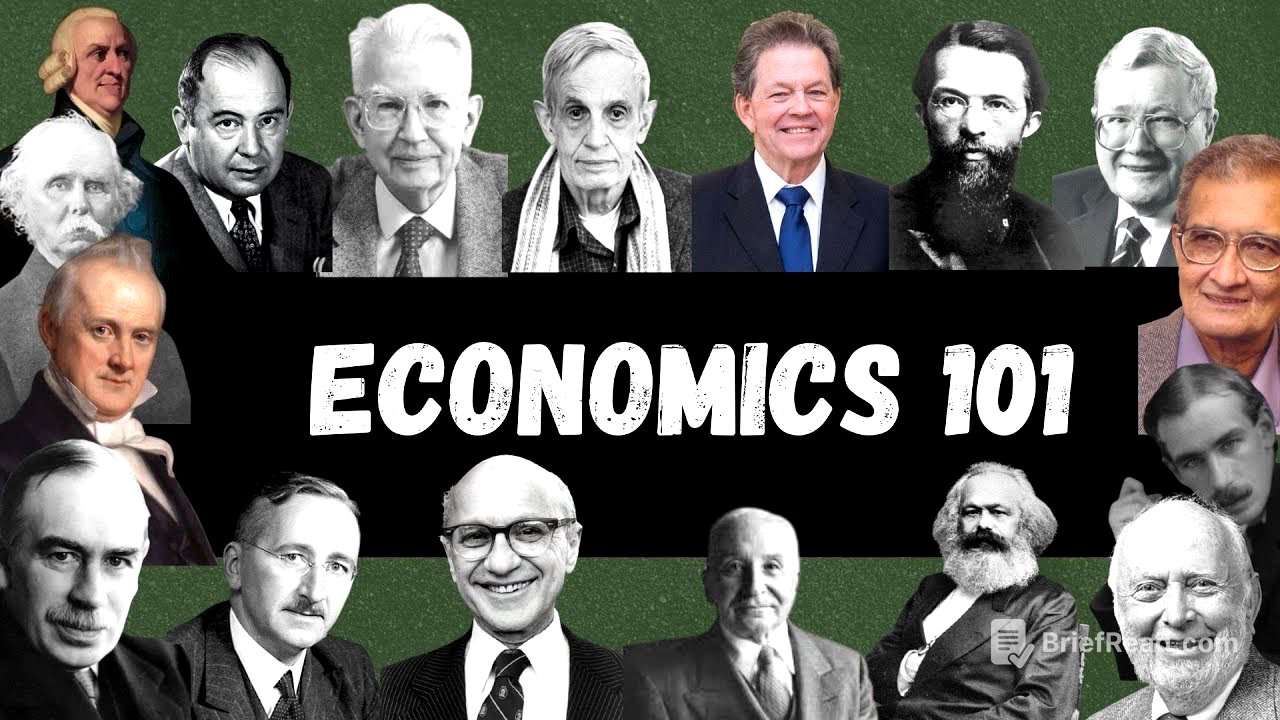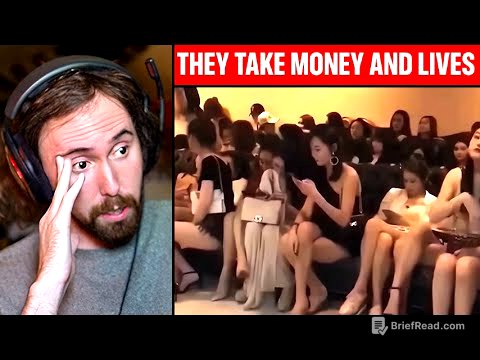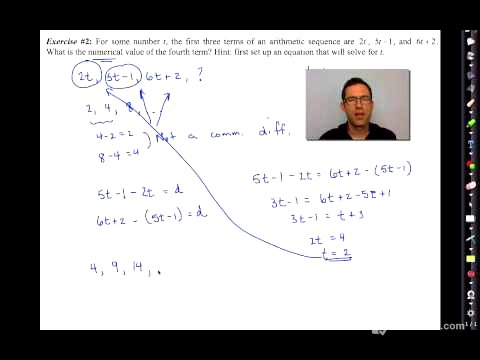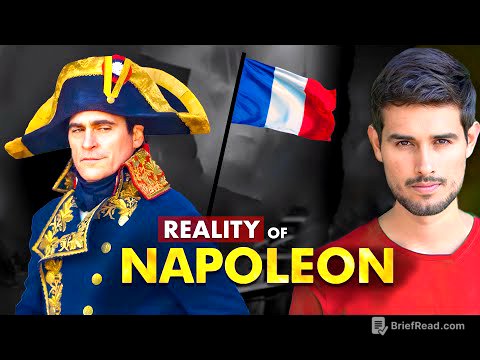TLDR;
This video provides an overview of various schools of economic thought, from classical economics to public choice theory. It explains the core ideas, key figures, and major contributions of each school, highlighting their perspectives on markets, government intervention, individual behavior, and economic development.
- Classical Economics: Emphasizes free markets and the "invisible hand."
- Marxian Economics: Focuses on labor exploitation and the inherent contradictions of capitalism.
- Game Theory: Analyzes strategic interactions and decision-making when outcomes depend on others' choices.
- Neoclassical Economics: Views the economy as a web of supply and demand, with rational individuals maximizing utility.
- Keynesian Economics: Advocates for government intervention to stabilize aggregate demand during recessions.
- Supply-Side Economics: Argues that tax cuts stimulate production and economic growth.
- Monetarism: Focuses on managing the money supply to control inflation.
- Development Economics: Examines the factors that contribute to economic prosperity in nations.
- Austrian School: Emphasizes individual action and criticizes central banking and planning.
- Behavioral Economics: Incorporates psychological insights to understand how cognitive biases affect economic decisions.
- New Institutional Economics: Focuses on the role of institutions in reducing transaction costs and shaping economic development.
- Public Choice Theory: Applies economic principles to analyze political behavior and government policies.
Classical Economics [0:00]
Classical economics, originating in the 18th century with Adam Smith's "The Wealth of Nations," views the economy as a self-regulating machine. Smith's concept of the "Invisible Hand" suggests that individuals pursuing their self-interest unintentionally create economic order. Classical economists, including David Ricardo, advocate for minimal government intervention, believing that prices, wages, and markets naturally adjust. Ricardo's theory of comparative advantage emphasizes that countries should specialize in producing goods they are relatively best at, promoting international trade and overall economic benefit.
Marxian Economics [1:30]
Karl Marx, writing during the Industrial Revolution, saw capitalism as a system rife with exploitation and inequality. At the core of Marxian economics is the labor theory of value, which posits that a product's true value derives from the human labor involved in its production. Marx argued that capitalists extract "surplus value" from workers by paying them less than the value they create, leading to exploitation. He believed that this exploitation would inevitably lead to revolution and the collapse of capitalism, replaced by socialism and eventually communism.
Game Theory [3:01]
Game theory, developed by John Von Neumann and John Nash, analyzes strategic interactions where individuals' success depends on others' choices. The prisoner's dilemma illustrates how rational self-interest can lead to suboptimal outcomes for all parties involved. Nash's concept of Nash equilibrium describes a state where no player can benefit by unilaterally changing their strategy. Game theory has applications in various fields, including business, international relations, and biology, helping to understand phenomena from price wars to climate change.
Neoclassical Economics [5:02]
Neoclassical economics, emerging in the late 19th century, focuses on individual choices and how they shape the economy. It introduces marginalism, the idea that value is derived from the additional satisfaction gained from one more unit of a good or service. Neoclassical economists view the economy as a complex web of supply and demand curves seeking equilibrium, assuming that individuals are rational actors maximizing their utility. The model of perfect competition, though rarely existing in reality, serves as a benchmark for measuring market efficiency and understanding price determination.
Keynesian Economics [6:36]
John Maynard Keynes challenged the notion that markets always self-correct, particularly during the Great Depression. Keynesian economics focuses on aggregate demand, arguing that government intervention is necessary to stabilize the economy during recessions. Keynes advocated for government spending to fill the gap when businesses and consumers reduce investment and spending, creating a multiplier effect that stimulates economic activity. He argued that thrift during a depression is detrimental to the overall economy.
Supply Side Economics [8:11]
Supply-side economics, popularized in the 1980s, emphasizes production and argues that tax cuts, especially for businesses and high earners, stimulate investment and economic growth. The theory suggests that lower tax rates can lead to increased government revenue through increased economic activity, illustrated by the Laffer curve. Supply Siders believe in trickle-down effects, where tax breaks for the wealthy lead to job creation and wage increases. While supply-side policies have been associated with economic booms, they have also coincided with growing deficits and inequality.
Monetarism [10:08]
Monetarism, led by Milton Friedman, challenges Keynesian economics by focusing on managing the money supply to control inflation. Monetarists argue that inflation is primarily a monetary phenomenon, resulting from printing too much money. Friedman advocated for a steady, predictable increase in the money supply and limited government intervention. Monetarists also introduced the concept of the natural rate of unemployment, suggesting that attempts to lower unemployment below this rate would only lead to inflation.
Development Economics [11:31]
Development economics examines the factors that contribute to economic prosperity in nations, focusing on institutions, culture, and history. It identifies poverty traps, where poverty itself prevents economic growth, and explores interventions like microfinance and conditional cash transfers to break these cycles. Development economics emphasizes the importance of institutions, property rights, rule of law, education systems, and political stability over raw resources or capital. Economic development involves transforming societies and building foundations for lasting prosperity through education, healthcare, and good governance.
Austrian School [13:53]
The Austrian School, founded by Carl Menger, emphasizes individual action and criticizes central banking and planning. Austrians attribute business cycles to central banks artificially lowering interest rates, leading to unsustainable investment and economic crashes. They critique central planning, arguing that no central planner can efficiently gather enough information to run an economy. The Austrian School values individual freedom and believes the economy should be left free to evolve naturally through the price system.
Behavioral Economics [15:19]
Behavioral economics incorporates psychological insights to understand how cognitive biases and mental shortcuts affect economic decisions. Research reveals that individuals are not always rational and are influenced by factors such as loss aversion, framing effects, and emotions. The concept of bounded rationality suggests that people make decisions that are "good enough" rather than optimal. Behavioral economics has implications for understanding market inefficiencies and designing nudges to help people make better choices.
New Institutional Economics [16:52]
New Institutional Economics (NIE) focuses on the role of institutions in reducing transaction costs and shaping economic development. NIE examines why institutions like corporations, laws, and property rights are necessary for economic exchanges. It emphasizes path dependence, how history shapes economic development, and the importance of building better institutions for prosperity. Good institutions, such as reliable courts and functioning markets, create the foundation for economic growth.
Public Choice Theory [18:23]
Public Choice Theory applies economic principles to analyze political behavior and government policies, assuming that politicians and bureaucrats are rational actors pursuing their own interests. It identifies the concept of concentrated benefits and dispersed costs, explaining why policies that harm the majority to benefit powerful minorities often persist. Public Choice theorists expose the myth of the public interest and suggest solutions such as constitutional rules, sunset clauses, and competition between jurisdictions to make self-interest serve the common good.









